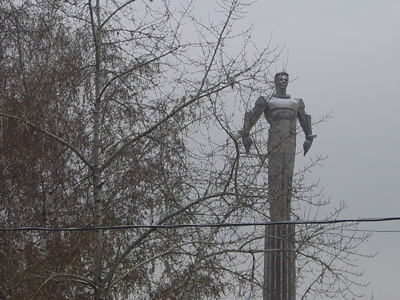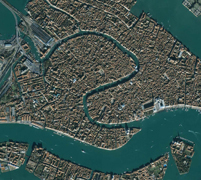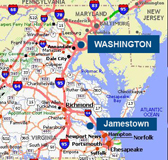
MOON BASE
EPISODE III
The Precursor Age
Science is but a perversion of itself
unless it has as its ultimate goal the betterment of humanity.
(Nikola Tesla)
(Nikola Tesla)
One of the aims of the Moon Base Conference is to create a network among people and institutions wishing to pick up the challenge of lunar manned exploration. A goal definitely achieved as quite naturally the line drawn from Venice to Washington quickly extended westward until it hit Moscow. The Russian experience in long-duration human presence in space as well as being the only other nation to have landed on the Moon deserved “in-situ” attention. Thus the opening of third Moon Base workshop was hosted at the headquarters of the Russian Academy of Sciences, just in front of the high pillar which brings the statue of Yuri Gagarin close to the sky.
During the 1.5 years spent from the early Venice Moon Base Workshop many things had changed. The exploration of the Moon became a top priority for many agencies, a worldwide co-ordination among them was set up for laying out the basis of international cooperation on space exploration, strategic positioning and financial considerations gained more solid ground. The Moon Base vision was also in motion. Refinements of the preliminary scenario involve a more precise sharing of “responsibilities” between humans and robots, until a precursor fully automated “lunar polygon” could be envisaged. In this respect it was of great interest listening during the Moscow Workshop to a rather exhaustive summary of the studies carried out over so many years of manned spaceflight. The experiments on astronauts living on MIR and ISS are ranging from monitoring the interaction of the human brain with cosmic rays (the sudden appearance of “flashes” has been repeatedly reported) to psychological aspects (e.g. avoiding the onset of “alienation” processes among the crewmembers), or to the development of techniques for counterbalancing the muscle and bone loss typical of long-duration weightless periods. In passing, this latter field of study represents a major return from space activities, as it is fruitfully applied on our planet to the restoration of psycho-motorial activities on people hit by severe illnesses or injuries. Coming back to exploration, there is no doubt that the existence of a large manned infrastructure in space is by no means one of the most important “precursor” opportunity for the Moon Base project.
 Yet the Moon is
orbiting almost exactly one thousand times further away than the ISS
does and transportation needs are a critical issue. Although it turns
out that the present/near future launcher capability is sufficient for
allowing the establishment of a lunar outpost, any means of decreasing
the energy requirements is of course highly welcome. Material science
and in-situ resources exploitation can do that by lowering dramatically
the dependence from the Earth. “Don’t bring everything to the Moon” is
a paradigm which opens many possibilities for the payloads on-board
near future precursor missions. Solar cells can be produced directly
from lunar regolith through an automatic procedure and this would start
the energetic independence of the Moon Base. The search for high ice
concentrations is of course a top priority and apart from the obvious
advantages for human survival, the possibility of producing propellant
on the Moon has deep implication on the whole architecture of long-term
lunar exploration. A deeper analysis of the peculiar topology of the
Earth-Moon space allows to see the utilization of the collinear
lagrangian points in a different light. In particular LL1 can be
regarded not only as a portal for lunar exploration or as a gateway to
interplanetary space, but as a location of a permanent “hub” for
sustaining all sorts of scientific and exploration missions. A scenario
that, to be effective, needs the availability of a low-cost access to
and from the lunar surface.
Yet the Moon is
orbiting almost exactly one thousand times further away than the ISS
does and transportation needs are a critical issue. Although it turns
out that the present/near future launcher capability is sufficient for
allowing the establishment of a lunar outpost, any means of decreasing
the energy requirements is of course highly welcome. Material science
and in-situ resources exploitation can do that by lowering dramatically
the dependence from the Earth. “Don’t bring everything to the Moon” is
a paradigm which opens many possibilities for the payloads on-board
near future precursor missions. Solar cells can be produced directly
from lunar regolith through an automatic procedure and this would start
the energetic independence of the Moon Base. The search for high ice
concentrations is of course a top priority and apart from the obvious
advantages for human survival, the possibility of producing propellant
on the Moon has deep implication on the whole architecture of long-term
lunar exploration. A deeper analysis of the peculiar topology of the
Earth-Moon space allows to see the utilization of the collinear
lagrangian points in a different light. In particular LL1 can be
regarded not only as a portal for lunar exploration or as a gateway to
interplanetary space, but as a location of a permanent “hub” for
sustaining all sorts of scientific and exploration missions. A scenario
that, to be effective, needs the availability of a low-cost access to
and from the lunar surface.On day-2 the conference moved to Starcity, the training location for past and present cosmonauts. Being there, while breathing the very history of human spaceflight, revived in all of us the feeling that astronauts are pioneers and the Moon is the next frontier.
ettore perozzi


